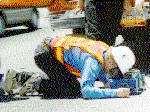U.S. Department of Transportation
Federal Highway Administration
1200 New Jersey Avenue, SE
Washington, DC 20590
202-366-4000
Focus
| Accelerating Infrastructure Innovations |
Publication Number: FHWA-SA-97-028
Date: October 1997
Alkali-silica reactivity (ASR), which occurs beneath the surface of portland cement concrete bridges and pavements, is difficult to detect. Often, the first indication of the problem comes after the damage has been done, when the concrete has begun to crack and spall.
The members of the Lead States team for alkali-silica reactivity-New Mexico, North Carolina, Pennsylvania, South Dakota, and Virginia-were among the first States to aggressively monitor their roads and bridges for evidence of ASR. They learned how to recognize the early stages of ASR, how to determine if a concrete mix will be susceptible to ASR, and how to prevent or minimize the reaction in concrete mixes. Now, the Lead States and their industry partners are sharing their experiences and developing new resources so other highway agencies can better understand and prevent the chemical reaction, as well as treat the damage it causes.
Margo Thomson of the Pennsylvania Department of Transportation (DOT) and leader of the ASR Lead States team, says the team is assembling a bibliography on ASR, as well as a list of resources, including equipment for diagnosing ASR and a roster of people who are available to provide technical assistance in evaluating, preventing, and treating ASR. The bibliography and the list of resources are scheduled to be available late this year.
In addition, the team is writing a draft specification on how to prevent or reduce the likelihood of ASR in concrete mixes.
To expand its pool of expertise, the team has recently added several new members from the research community:
The members of the Lead States team for ASR offer technical assistance in identifying ASR and in developing concrete mix specifications that reduce the likelihood of ASR.
Thomson emphasizes that technical assistance will be available to local governments, as well as State agencies. "The word about the problem and how to address it hasn't reached the local governments," she says. "We need to get local municipalities up to speed on ASR and how to deal with it in terms of specifications for new concrete."
For more information on the Lead States team for ASR, contact Margo Thomson at Pennsylvania DOT (phone: 717-787-1931; fax: 717-783-5955; email: mct@ezonline.com).

An engineer checks for signs of alkali-silica reactivity on a test section on Lomas Boulevard in Albuquerque, New Mexico. The test section, part of a SHRP product, by New Mexico DOT, one of the members of the ASR Lead States team.
For technical assistance with ASR, contact: